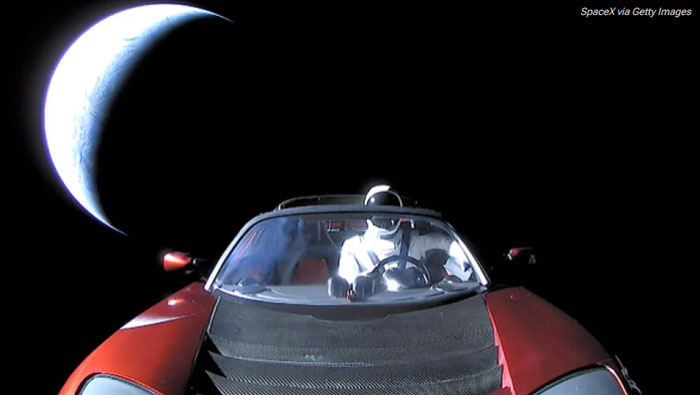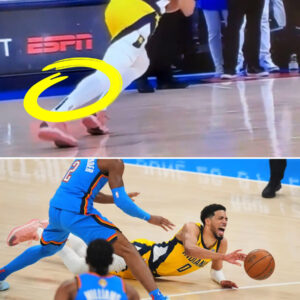In total, the Roadster traveled more than 4 billion kilometers in space, mostly in a vacuum.
Half a decade has passed since SpaceX attracted public attention with Elon Musk’s decision to launch Elon Musk’s 2018 Tesla Roadster electric sports car into space, sending the car on an endless journey in the nowhere region of the solar system, where it is supposed to “wander” for millennia to come.
On February 6, the cherry-colored electric sports car was officially in space for exactly 5 years. At the time of the anniversary, estimated data showed it had completed about 3 and 1/4 of its orbits around the sun and was located about 203 million miles (327 million kilometers) from Earth, according to tracking website whereisroadster.com.
In total, the Roadster traveled more than 4 billion kilometers in space, mostly in a vacuum. However, in 2020, this vehicle made its first close approach to Mars at a range of 8 million kilometers, or 20 times the distance between Earth and the moon.

However, it is difficult to pinpoint the exact location of the car. We also don’t know if it was intact, as the car could have been hit by a meteorite resulting in complete destruction, or eroded to the point where it could not be recognized by radiation. There haven’t been any direct observations of the Roadster since 2018, weeks after it was launched into orbit on a Falcon Heavy rocket. Current data is based solely on calculated estimates of the vehicle’s trajectory.
Astronomers themselves do not have much incentive to actively monitor the car, as it does not bring much scientific value.
Before being launched into orbit, Tesla’s vehicle was intended to serve as a “dummy block” for the first mission of the Falcon Heavy rocket in February 2018, a launch that even Musk had predicted would only have a 50-50 success rate.
But in the end, the launch went smoothly. And the car has been orbiting the sun ever since, following an oblong line, as far as Mars’ orbital line and as close to the sun as Earth’s orbit.
Before being launched into space in 2018, SpaceX loaded the vehicle with various objects. Behind the wheel is a dummy dressed in an astronaut suit, nicknamed Starman. On the dashboard, a sign reads “Don’t panic,” a reference to the popular science fiction novel, “The Hitchhiker’s Guide to the Galaxy.”
There is also a data storage device containing the works of science fiction writer Isaac Asminov and a plaque with the names of thousands of SpaceX employees.
Elon Musk once shared that he hopes that one day humans will establish settlements on other planets in the solar system – a long-term dream of Musk, which is also the foundation for SpaceX’s declared mission to colonize Mars.
And when that happens, Musk said he hopes “his descendants will be able to pull (the Roadster) back to the museum.”
For now, however, the Roadster isn’t likely to go near another planet until 2035, when it passes by Mars again.
After that, it will have two flybys of Earth at distances of several million miles in 2047 and 2050, according to NASA data.
A 2018 study also estimated that the chance of a roadster colliding with Earth within the next 15 million years is about 22%. The chance of it hitting Venus or the Sun is 12%. If the electric car collides with Earth, it is ripped to pieces as it plunges back into the atmosphere.
News
Dave Crosby, the individual who captured the attention of all three Voice Judges in record time. Watch his incredible performance – it’s truly astonishing!
From the moment he graced the stage, it was evident that a remarkable performance was about to unfold. As Dave serenaded the room, a captivating melody filled…
Tom Brady Sparks New Dating Rumors After Being Spotted Out At Dinner With Popular Sideline Reporter
Tom Brady has set off another wave of dating speculation following his brief romance with Irina Shayk. According to TMZ, the former NFL star was spotted out in Beverly…
REPORT: Several Chiefs & Dolphins Players Suffered Frostbite During Saturday’s Grueling Playoff Showdown
Multiple players are said to have suffered frostbite during Saturday night’s playoff showdown between the Kansas City Chiefs and Miami Dolphins at Arrowhead Stadium. The game was the fourth-coldest in NFL…
Female Eagles Fan Unleashed All Sorts Of Cruel, NSFW Insults Towards Bucs Fans After Her Team’s Ugly Wild Card Loss In Tampa (VIDEO)
A female Eagles fan went off on Buccaneers supporters after having to sit through a frustrating Wild Card fixture in which her team put just nine points…
Female Eagles Fan Unleashed All Sorts Of Cruel, NSFW Insults Towards Bucs Fans After Her Team’s Ugly Wild Card Loss In Tampa (VIDEO)
A female Eagles fan went off on Buccaneers supporters after having to sit through a frustrating Wild Card fixture in which her team put just nine points…
Jalen Hurts Had An Interesting 7-Word Response After Being Asked If He Wants Nick Sirianni To Remain The Eagles’ Head Coach (VIDEO)
Jalen Hurts has taken an exit at the first opportunity as his Eagles are out of the playoffs following a season in which they raced to 10-1 before…
End of content
No more pages to load











